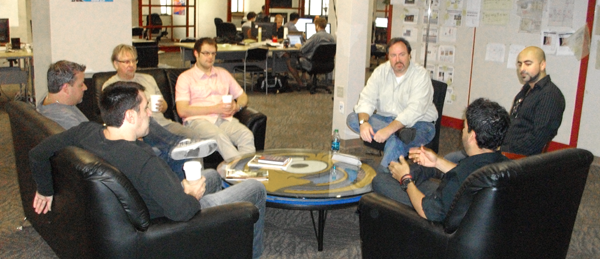The CheckMate Advisory Board met last week at TurboSquid headquarters in New Orleans, and what a meeting it was! Over the two-day conference, Board members discussed a variety of topics ranging from UVs and gamma correction to outsourcing and education.

Advisory Board members meet at the TurboSquid headquarters. Clockwise from lower left: Jerome Denjean (Blur Studio), Fred Ruff (Bent Image Lab), Rob Wright (CNN), James Ogle (Weta Digital), Beau Perschall (TurboSquid), Viken Majoulian (Electronic Arts), Carlos Cristerna (Neoscape).
Some of the key takeaways from the meeting:
Accuracy and Reference Materials
Because 3D models are used for match moving and compositing so often that high accuracy of real-world objects is extremely important. When a customer positions the model over a still from the live action footage or photo, they should match perfectly.
For stock 3D, Advisory Board members asked that artists put in the product description the method they used to build the item accurately. If the artist has photos he can use as thumbnails, he should put up a photo of the item used as reference (clearly marked as a photo so customers don’t think it’s a rendering) and then a second thumbnail showing the model overlaid on the photo. If the artist can’t include these images, he should explain which types of reference that were used and where they came from.
What this means for TurboSquid artists: When you publish a model of a real-world object, especially vehicles and street elements (which are frequently used in match-moving), include the information described above. Remember that you cannot include exterior websites in your product description, but you can describe them. Example: “Reference used: Photos from XYZ Airlines website gallery.”
What this means for CheckMate: We’re considering having this requirement as part of a “CheckMate Plus” standard in the future. Start doing this now, and you’ll be ready!
Levels of Detail
For any type of model, the ideal is to have three models available with different levels of detail.
- Background model. Intended for display in less than 1% of total screen space. Low poly with great textures. Example: A car at the back of a large parking lot. Basic mirrors and hood ornaments modeled, but grill and door handles represented by textures. No interior necessary.
- Midground model. Intended for display in less than 10% of screen space. Convex details modeled, concave details textured. Example: A car in a parking lot, parked closer to the camera than a background model. This is not just a subdivided version of the Background model. For example, the grill and door handle would be modeled, but tire treads and headlights would be represented by textures. Low-poly interior for items above seat level.
- Foreground (Hero) model. Enough detail to look good when displayed in 100% of screen space or extreme close-ups. Example: A car right in front of the camera. Tire treads and headlights would be fully modeled, and even the stitching on interior seats.
Since the Hero model almost always needs to be customized, and they know about the need for the model well ahead of time based on storyboards, production artists will usually build it themselves. They might use a purchased Midground model as the basis for a custom-built Hero model. All other models of real-world objects, both Background and Midground, can usually be purchased from a stock 3D site.
A special case for a stock Hero model is when an Art Director decides at the last minute that he wants to change the storyboard and zoom into a Background or Midground model instead. If there’s no Hero model handy, the production facility might buy one from a stock 3D site to avoid having to wait for an in-house artist to build it. This situation isn’t as common as purchase of Midground and Background models, but if the customer needs a Hero model and a high-quality model of this type is available in stock 3D, they’ll pay top dollar for it. But until there’s a detailed Hero model for every conceivable item in the world with all possible variations, production artists will continue to use stock 3D mostly for Background and Midground.
“Even if we aren’t sure we’ll need them, we’d probably buy both of them just in case,” said one Advisory Board member.
This doesn’t mean they’ll never purchase a Hero model. If they find one that works for them, they’ll buy it. But this situation is less common than finding Midground and Background models that suit their needs.
What this means for TurboSquid artists: Having both a Midground and Background version of a model available at TurboSquid as separate products, with product IDs for each listed on the other’s description, will help customers purchase model pairs that will take them all the way through a project. If you have a Hero version too, refer to that one in the Midground and Background product descriptions as well.
What this means for CheckMate: We’re not sure yet. Advisory Board members said they’d like to be able to purchase packaged sets of 2 or 3 models with different levels of detail (LODs), but CheckMate currently allows only one model per product. We’d like to see some artists putting up separate products as described above, and let’s see how they sell. We do plan to allow collections in CheckMate soon, so that might be a solution for bundling sets of two or three models with different LODs.
The Future of CheckMate
These points just scratch the surface of what the CheckMate Advisory Board talked about. We’ll post a more comprehensive list of takeaways, plus some video interviews with Board members, in the coming weeks.
Many of the discussion points will lead to future changes to the CheckMate standard. You can get a jump on quality now by utilizing this information when you publish your new 3D models at TurboSquid.
